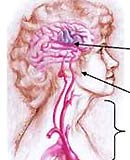Sudden blurred vision can be a sign of transient ischemic attack – a warning sign of a potential stroke in the near future.
 |
(Image: SK&DS) |
Transient ischemic attack (TIA) refers to a temporary reduction in brain function lasting less than 24 hours due to inadequate blood flow to a part of the brain. This condition can cause a loss of function in the body area controlled by the affected part of the brain.
The primary causes of transient ischemic attack are typically blood clots that form naturally in the blood vessels of the brain or originate from other areas and travel via blood flow, blocking cerebral arteries. Additionally, vasospasm and bleeding can also lead to transient ischemic attacks. Many refer to this phenomenon as a “mini-stroke.”
In some cases, a transient ischemic attack may develop gradually, while in others, it can progress very rapidly. A full-blown stroke usually lasts longer than a transient ischemic attack, indicating severe and permanent damage.
Although transient ischemic attacks typically last only a few minutes before resolving, neurologists recommend treating these events as emergencies to prevent recurrence. A TIA can occur once or multiple times, potentially leading to a real stroke.
Symptoms of the Condition
A transient ischemic attack due to blockage of the eye artery can cause temporary vision loss, with the patient experiencing sudden blurred vision. TIAs involving the carotid artery can result in loss of movement and sensation on one side; patients may experience paralysis of the arm, leg, face, or even the entire side of the body. Symptoms may also include an inability to control an arm, difficulty walking, seeing double, slurred speech while still being able to comprehend, dizziness, and loss of balance. These symptoms are typically very brief, hence the term “transient.”
These symptoms indicate a localized problem in the brain, which may be due to narrowed cerebral arteries or blood clots traveling from the heart to the brain. This condition also highlights a connection with atherosclerosis and may reflect underlying issues such as diabetes, high cholesterol, and hypertension.
Management of Transient Ischemic Attack
Transient ischemic attacks can cause unusual symptoms that arise very quickly. Therefore, when such signs appear suddenly, the patient should be in a resting position (lying flat to ensure optimal blood flow to the brain). Engaging in physical activity or experiencing strong emotions should be avoided to prevent a full-blown stroke.
Subsequently, the patient needs to undergo a medical evaluation that includes blood sugar tests, blood pressure measurements, angiography, and coagulation tests to identify the underlying cause and initiate prompt treatment.
Patients should not self-medicate with anticoagulants or rapid blood pressure-lowering medications. Careful examination and medication should only be administered under a physician’s guidance, as improper use could exacerbate the condition.
Transient ischemic attacks are more common in individuals who are overweight or obese, have high blood pressure, high cholesterol, and elevated blood sugar levels, especially in those over 50 years old. In smokers, this condition can occur earlier.
Preventive measures should begin with a diet rich in fiber, low in fats, sugars, and salt, and abundant in vitamins. It is advisable to consume plenty of vegetables and fresh fruits while limiting stimulants like alcohol, coffee, and absolutely avoiding smoking, which is a root cause not only of strokes but also of other chronic and life-threatening diseases such as cancer and cardiovascular issues.
Regular physical exercise is also a crucial measure that significantly reduces the risk of disease. Some accessible forms of exercise for many include walking or light jogging. It is recommended to exercise at least three times a week for a minimum of 30 minutes each session. For those with joint pain or arthritis, swimming may be the most suitable form of exercise.
Dr. Nguyen Hoang Nam


















































